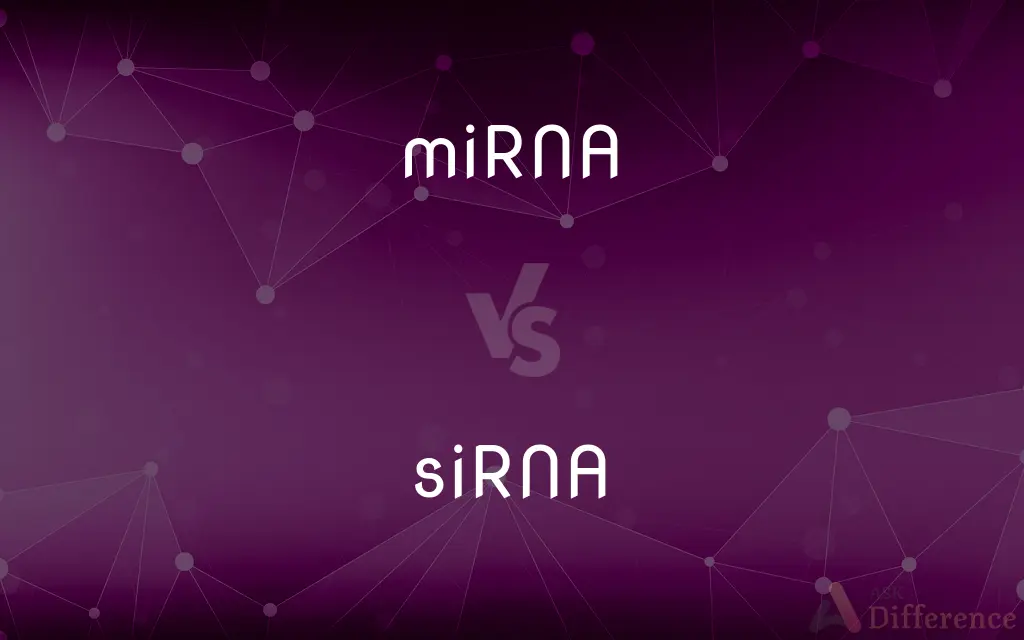miRNA vs. siRNA — What's the Difference?
By Tayyaba Rehman — Published on January 11, 2024
miRNA consists of small RNA molecules that regulate gene expression post-transcriptionally. siRNA is a double-stranded RNA that silences specific genes through RNA interference.

Difference Between miRNA and siRNA
Table of Contents
ADVERTISEMENT
Key Differences
miRNA (microRNA) is a class of small, single-stranded RNA molecules, typically about 22 nucleotides long, involved in regulating gene expression. These molecules bind to target messenger RNA (mRNA) and can inhibit protein production or degrade the mRNA. miRNA plays a crucial role in various biological processes, including development, cell differentiation, and disease progression.
On the other hand, siRNA (small interfering RNA) is usually double-stranded, around 20-25 nucleotides in length. It is involved in the RNA interference pathway, where it leads to the degradation of specific mRNA molecules, effectively silencing the expression of certain genes. siRNA is often used in research to study gene function by selectively silencing genes.
miRNA is processed from longer precursors and usually has imperfect pairing with its target mRNA. This imperfect pairing allows a single miRNA to target multiple mRNAs, providing a broad regulatory function. miRNAs are involved in fine-tuning gene expression and are often implicated in complex cellular processes.
siRNA, in contrast, has a perfect or nearly perfect match with its target mRNA. This specificity allows siRNA to precisely target and degrade specific mRNA sequences. siRNA is a powerful tool in gene silencing experiments and therapeutic applications, such as targeting disease-related genes.
In summary, while both miRNA and siRNA are involved in regulating gene expression, they differ in their origins, structures, mechanisms of action, and roles in the cell. miRNA is more involved in broad regulatory roles, while siRNA provides a precise method for silencing specific genes.
ADVERTISEMENT
Comparison Chart
Structure
Single-stranded
Double-stranded
Length
About 22 nucleotides
20-25 nucleotides
Origin
Processed from longer precursors
Derived from long double-stranded RNA or specific transgenes
Target Pairing
Imperfect pairing with target mRNA
Perfect or nearly perfect match with target mRNA
Function
Regulates gene expression, involved in development and disease
Silences specific genes, used in research and therapeutics
Compare with Definitions
miRNA
MiRNA plays a crucial role in various biological processes and development.
Abnormal miRNA levels were linked to developmental disorders in the study.
siRNA
SiRNA are double-stranded RNA molecules that silence specific genes.
Researchers used siRNA to knock down the expression of a cancer-related gene.
miRNA
MiRNA molecules are typically around 22 nucleotides in length.
The identified miRNA was exactly 22 nucleotides long.
siRNA
SiRNA is involved in the RNA interference pathway.
The siRNA successfully triggered RNA interference, silencing the targeted mRNA.
miRNA
MiRNA are small RNA molecules that regulate gene expression post-transcriptionally.
Scientists discovered a new miRNA involved in tumor suppression.
siRNA
SiRNA requires perfect or near-perfect complementarity with its target mRNA.
Precise base pairing was crucial for the siRNA to effectively silence the gene.
miRNA
MiRNA functions by binding to complementary sequences in mRNA molecules.
The miRNA effectively downregulated the targeted gene's expression.
siRNA
SiRNA is used in research and therapeutics for gene silencing.
SiRNA therapy showed promise in treating the genetic disorder in the clinical trial.
miRNA
MiRNA can target multiple genes due to imperfect base pairing.
The versatility of miRNA in targeting several genes was key to its regulatory function.
siRNA
SiRNA has a specific length, usually 20-25 nucleotides.
The designed siRNA was 21 nucleotides long for optimal gene silencing.
miRNA
MicroRNA
siRNA
Alternative form of siRNA
Common Curiosities
How does siRNA function?
siRNA functions by causing the degradation of specific mRNA molecules, silencing genes.
What roles do miRNAs play in the cell?
miRNAs are involved in regulating gene expression, development, and various cellular processes.
What is the typical length of siRNA?
siRNA is typically 20-25 nucleotides in length.
Are miRNAs single or double-stranded?
miRNAs are single-stranded RNA molecules.
What is miRNA?
miRNA is a type of small RNA molecule that regulates gene expression post-transcriptionally.
How specific is siRNA to its target?
siRNA requires perfect or near-perfect complementarity to its target mRNA for effective silencing.
What is the mechanism of action of miRNA?
miRNA binds to complementary sequences in mRNA, inhibiting protein production or causing mRNA degradation.
Can miRNA target multiple genes?
Yes, miRNA can target multiple genes due to its imperfect base pairing with mRNA.
Is siRNA used in therapeutic applications?
Yes, siRNA is used in research and therapeutic applications for specific gene silencing.
Do miRNA and siRNA have therapeutic potential?
Both miRNA and siRNA hold therapeutic potential, particularly in targeting disease-related genes.
Where do miRNAs come from?
miRNAs are processed from longer RNA precursors.
Are miRNA and siRNA involved in the same cellular processes?
While both are involved in gene regulation, they function in different pathways and have distinct roles in the cell.
What is the role of miRNA in disease?
miRNA can play a role in the progression of diseases, including cancer and developmental disorders.
How is siRNA produced in the laboratory?
siRNA can be produced by processing long double-stranded RNA or from specific transgenes.
Can siRNA be used in gene function studies?
Yes, siRNA is commonly used in research to study gene function by selectively silencing genes.
Share Your Discovery

Previous Comparison
ADSL vs. VDSL
Next Comparison
NPN Transistor vs. PNP TransistorAuthor Spotlight
Written by
Tayyaba RehmanTayyaba Rehman is a distinguished writer, currently serving as a primary contributor to askdifference.com. As a researcher in semantics and etymology, Tayyaba's passion for the complexity of languages and their distinctions has found a perfect home on the platform. Tayyaba delves into the intricacies of language, distinguishing between commonly confused words and phrases, thereby providing clarity for readers worldwide.











































